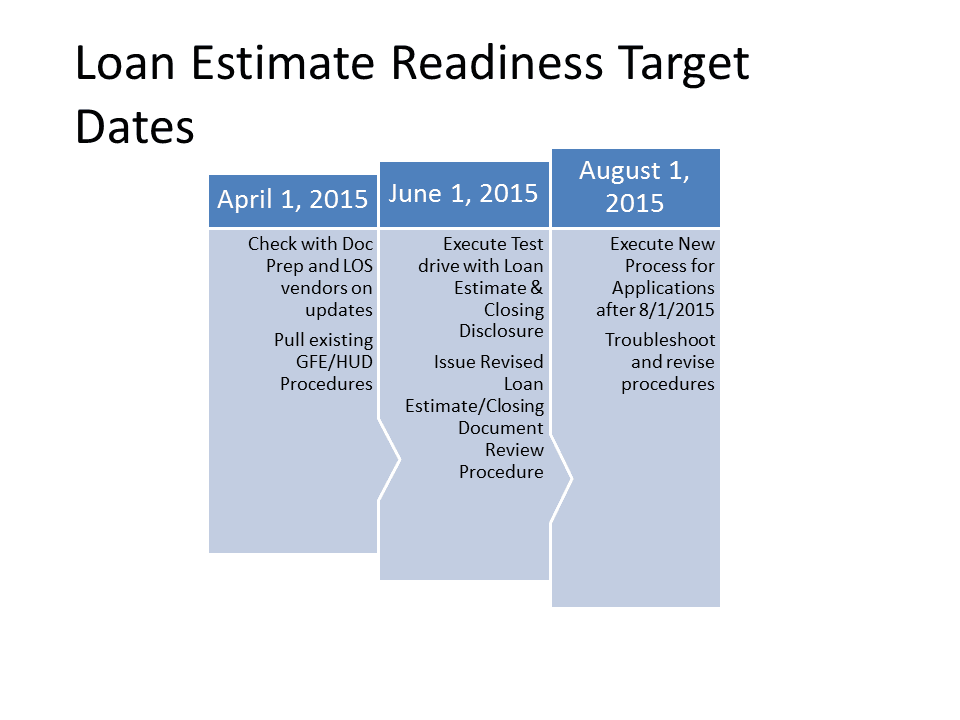

This form will be provided to consumers within three business days after they submit a loan application. The first new form (the Loan Estimate) is designed to provide disclosures that will be helpful to consumers in understanding the key features, costs, and risks of the mortgage for which they are applying. The Final Rule summed up these disclosures and their purpose as follows: The Settlement Cost Booklet was changed and is now call ed “Your Home Loan Toolkit” and combined them to create two new disclosures, the Loan Estimate and the Closing Disclosure. This overhaul essentially did away with certain lending disclosures such as the Good Faith Estimate, Preliminary Truth in Lending Disclosure, HUD Settlement Statement, Final Truth in Lending Disclosure, etc. The TRID rules established new disclosure requirements for most closed-end, consumer credit transactions secured by real property (dirt) and compliance with the new rules was mandatory for applications taken on or after October 3, 2015. The TRID requirements were born from an overhaul of both the Truth in Lending Act (Regulation Z) and the Real Estate Settlement Procedures Act (RESPA-Regulation X) in 2013. Note: visit our page about Goal Seek for more examples and tips.Truth in Lending/RESPA Integrated Disclosures – TRID

You need to sell 90% of the books for the highest price to obtain a total profit of exactly $4700. Click in the 'By changing cell' box and select cell C4. Click in the 'To value' box and type 4700.ĥ. What if you want to know how many books you need to sell for the highest price, to obtain a total profit of exactly $4700? You can use Excel's Goal Seek feature to find the answer.Ĥ. That's how easy what-if analysis in Excel can be. Next, select cell D10 (total profit) for the result cell and click on OK.Ĭonclusion: if you sell 70% for the highest price, you obtain a total profit of $4100, if you sell 80% for the highest price, you obtain a total profit of $4400, etc. Click the Summary button in the Scenario Manager.Ģ. To easily compare the results of these scenarios, execute the following steps.ġ. Excel will change the value of cell C4 accordingly for you to see the corresponding result on the sheet. Note: to see the result of a scenario, select the scenario and click on the Show button. Next, add 4 other scenarios (70%, 80%, 90% and 100%).įinally, your Scenario Manager should be consistent with the picture below: Enter the corresponding value 0.6 and click on OK again.Ħ. Type a name (60% highest), select cell C4 (% sold for the highest price) for the Changing cells and click on OK.ĥ. On the Data tab, in the Forecast group, click What-If Analysis.Ĥ. However, what-if analysis enables you to easily compare the results of different scenarios. Note: You can simply type in a different percentage into cell C4 to see the corresponding result of a scenario in cell D10. You can use the Scenario Manager to create these scenarios. Create Different Scenariosīut what if you sell 70% for the highest price? And what if you sell 80% for the highest price? Or 90%, or even 100%? Each different percentage is a different scenario. If you sell 60% for the highest price, cell D10 calculates a total profit of 60 * $50 + 40 * $20 = $3800.


 0 kommentar(er)
0 kommentar(er)
